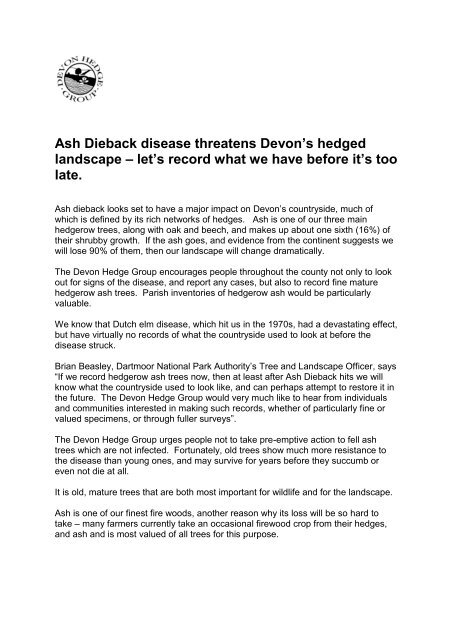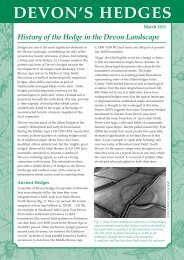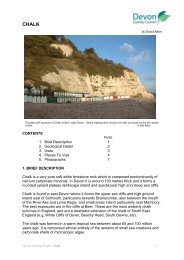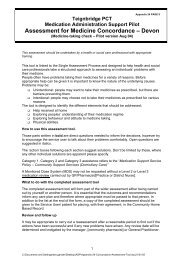Ash Dieback disease threatens Devon's hedged landscape – let's ...
Ash Dieback disease threatens Devon's hedged landscape – let's ...
Ash Dieback disease threatens Devon's hedged landscape – let's ...
Create successful ePaper yourself
Turn your PDF publications into a flip-book with our unique Google optimized e-Paper software.
<strong>Ash</strong> <strong>Dieback</strong> <strong>disease</strong> <strong>threatens</strong> Devon’s <strong>hedged</strong><br />
<strong>landscape</strong> <strong>–</strong> let’s record what we have before it’s too<br />
late.<br />
<strong>Ash</strong> dieback looks set to have a major impact on Devon’s countryside, much of<br />
which is defined by its rich networks of hedges. <strong>Ash</strong> is one of our three main<br />
hedgerow trees, along with oak and beech, and makes up about one sixth (16%) of<br />
their shrubby growth. If the ash goes, and evidence from the continent suggests we<br />
will lose 90% of them, then our <strong>landscape</strong> will change dramatically.<br />
The Devon Hedge Group encourages people throughout the county not only to look<br />
out for signs of the <strong>disease</strong>, and report any cases, but also to record fine mature<br />
hedgerow ash trees. Parish inventories of hedgerow ash would be particularly<br />
valuable.<br />
We know that Dutch elm <strong>disease</strong>, which hit us in the 1970s, had a devastating effect,<br />
but have virtually no records of what the countryside used to look at before the<br />
<strong>disease</strong> struck.<br />
Brian Beasley, Dartmoor National Park Authority’s Tree and Landscape Officer, says<br />
“If we record hedgerow ash trees now, then at least after <strong>Ash</strong> <strong>Dieback</strong> hits we will<br />
know what the countryside used to look like, and can perhaps attempt to restore it in<br />
the future. The Devon Hedge Group would very much like to hear from individuals<br />
and communities interested in making such records, whether of particularly fine or<br />
valued specimens, or through fuller surveys”.<br />
The Devon Hedge Group urges people not to take pre-emptive action to fell ash<br />
trees which are not infected. Fortunately, old trees show much more resistance to<br />
the <strong>disease</strong> than young ones, and may survive for years before they succumb or<br />
even not die at all.<br />
It is old, mature trees that are both most important for wildlife and for the <strong>landscape</strong>.<br />
<strong>Ash</strong> is one of our finest fire woods, another reason why its loss will be so hard to<br />
take <strong>–</strong> many farmers currently take an occasional firewood crop from their hedges,<br />
and ash and is most valued of all trees for this purpose.
Contacts:<br />
Brian Beasley. Dartmoor National Park Authority, Trees and Landscape Officer.<br />
01626 831002. bbeasley@dartmoor.gov.uk.<br />
Robert Wolton. Chairman, Devon Hedge Group. 01837 810416.<br />
robertwolton@yahoo.co.uk.<br />
Photos of ash trees in hedges are available free from Robert Wolton<br />
Further information<br />
The <strong>disease</strong><br />
<strong>Ash</strong> dieback <strong>disease</strong> is a fungal infection caused by Chalara fraxinea. The <strong>disease</strong><br />
causes leaf loss and crown die back in affected trees. Infected trees are unlikely to<br />
survive and it is predicted that over 90% of Britain’s ash trees could be lost to the<br />
infection. Young trees are likely to die in the first season of infection with large<br />
mature trees taking several years to die.<br />
To date the infection has been confirmed at 549 sites throughout the UK, 24 in<br />
nurseries, 336 on newly planted sites and 189 in the wider environment. Most of the<br />
infected sites are in the south east and some of these infections may have been<br />
caused by wind carried spores from the continent. Few infected sites have been<br />
identified in the south west, most of these infected sites are on recently planted sites<br />
although one site trees in the wider environment have been infected.<br />
What does ash die back <strong>disease</strong> look like?<br />
There are a wide range of symptoms associated with ash dieback including:<br />
foliage wilt <strong>–</strong> black/brown leaves may be retained;<br />
shoot dieback with brownish to orange discolouration, often multiple<br />
shoots<br />
elongated angular stem lesions, often diamond shaped.<br />
small white fruiting bodies growing on stalks of fallen ash leaves<br />
staining of wood under bark<br />
For further information on identifying the <strong>disease</strong> visit the Forestry Commission’s<br />
web site at http://www.forestry.gov.uk/chalara<br />
What to do if you spot unhealthy ash trees<br />
Any suspected sighting should be reported to the Forestry Commission via the<br />
Chalara helpline (plant.health@forestry.gsi.gov.uk). The Forestry Commission or<br />
FERA will investigate and if a case is confirmed they will take appropriate action.<br />
Unlike Phytophtora DEFRA is not recommending total removal of infected trees, they<br />
are requiring the removal of infected trees in nurseries and on newly planted sites,<br />
but woodland and hedgerow trees will be left in situ. It is hoped that some trees will<br />
show resistance to the <strong>disease</strong> and they can used as a seed source for the next<br />
generation.
The wildlife of ash trees<br />
<strong>Ash</strong> supports much wildlife, with quite a few species depending solely on it for their<br />
survival. Trunks frequently support rich moss and lichen communities, and moths<br />
like the Coronet are dependent on it <strong>–</strong> their caterpillars will eat only ash leaves. The<br />
seeds, or ‘keys’, provide much food for birds, including rarities like the Hawfinch, and<br />
when they fall to the ground for small mammals. Rot holes in ash are particularly<br />
good for rare flies and beetles, while other signs of maturity, like cracks, splits and<br />
hollows, provide roosting and breeding places for many types of bat.<br />
Devon’s hedges<br />
Devon’s hedges are truly world class. In a country famed for its hedgerows, Devon<br />
has a larger and more intact hedgerow heritage than any other county in<br />
Britain. Most of the county’s hedgerows are ancient, most dating back to Medieval<br />
times or before, and through their rich and intricate patterns tell the story of Devon’s<br />
<strong>landscape</strong> and farming traditions over many centuries. They are a distinctive feature<br />
of our countryside, important culturally, of great value to wildlife including threatened<br />
species like the dormouse, and deliver numerous other public benefits like soil<br />
protection, water regulation and carbon storage.<br />
The Devon Hedge Group<br />
The Devon Hedge Group is a forum of organisations and individuals interested in<br />
working together to promote the appreciation and conservation of hedges found<br />
across the county. Members of the Group represent the full range of interests<br />
associated with hedges in Devon, including agriculture, the conservation of wildlife<br />
and <strong>landscape</strong>, and historical and cultural values.<br />
12 August 2013, Devon Hedge Group
















